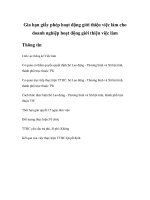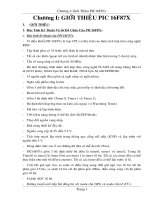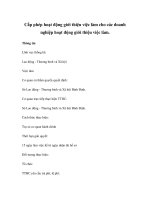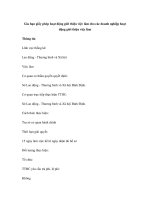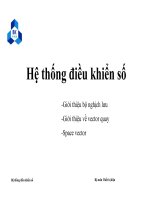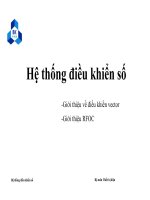Giới thiệu về xe Fliu Transfer
Bạn đang xem bản rút gọn của tài liệu. Xem và tải ngay bản đầy đủ của tài liệu tại đây (128.67 KB, 5 trang )
SECTION Ⅵ – PHẦN VI
MAINTENANCE – BẢO TRÌ
6.5 CASING GASKET INSTALLATION – LẮP ĐẶT VỎ GASKET
(VÒNG ĐỆM)
In general, new gaskets should be installed in the pump after the pump
has been dismantled. The gaskets should be of the same material and
thickness as the original gasket so it will compress to the same
thickness.
Nói chung, các vịng đệm mới nên được lắp đặt trong bơm sau khi bơm
đã được tháo rời.
Các miếng đệm nên có cùng một vật liệu và độ dày như gioăng ban đầu để nó sẽ nén đến
độ dày tương tự.
6.6 MAINTENANCE OF WEARING RINGS
All pumps come equipped with renewable wearing rings as standard
construction.
Generally it is recommended that the rings be renewed when the
original clearance has doubled. The renewal of the wearing rings will
depend upon required pump performance since capacity will fall off as
the radial clearance at the running joint increases due to wear.
6.7 MAINTENANCE OF SHAFT AND SHAFT SLEEVE
When the pump is dismantled, examine the shaft carefully. Its
condition should be checked at the impeller hub fit, under the shaft
sleeve and at the bearings.
The shaft may become damaged by corrosion, due to leakage along
the shaft, at the impeller or shaft sleeve.
Anti-friction bearings improperly fitted to the pump shaft will result in
the inner race rotation on the shaft , thus causing undue damage.
Check the shaft keyway for distortion.
Check the shaft runout at the impeller and coupling seat with a dial
indicator by supporting the shaft journals on “V”blocks or rollers.
Replace a shaft that is bent or distorted ( maximum 0.05 ㎜ ).
6.8 MAINTENANCE OF BEARINGS
Anti-friction bearings are usually pressed or shrunk on the shaft and a
pulling device must be used to remove them. The pulling jaws or
fingers must be located behind the shoulder of the inner race. When
other parts on a shaft do not interfere the bearing may be supported
by a split ring and the shaft pressed out using an arbor press.
NOTE : Unless extreme care is used when removing an anti-friction
bearing, the bearing may be damaged to the extent that it is no longer
1
useable. Always check the bearing immediately after removal for any
imperfections or any play between the races.
It is recommended that new bearings be used for replacement of
removed bearings sine very often damage caused by removal cannot
be detected until the pump is put into operation. When mounting antifriction bearings on the pump shaft remember that the satisfactory
operation of anti-friction bearings requires that the inner race be firmly
held on the shaft so that it cannot turn on the shaft.
It also is important the fit of the outer race prevent its free rotation in
the housing.
There are two methods in use for mounting a bearing on a pump
shaft :
1. Heating the bearing to expand the inner race and shrinking it on the
shaft.
2. Forcing the bearing onto the shaft.
The first method is referred. Heat the bearing in an oil bath or electric
oven to a uniform temperature of 80 - 120℃. When heated, quickly
mount it on the shaft.
If the alternate method is used, apply the force by means of an arbor
press or hammer blows.
If an arbor press is available, use a tubular sleeve, a ring, or small
blocks of equal thickness to apply the force to the inner race. With a
proper care it is possible to drive a bearing onto a shaft by hammering
on the center of a block of metal or wood mounted on top of a tubular
sleeve held against the inner race.
2
In forcing a bearing onto a shaft be careful that the race is never
cocked. Check the position of the bearing on the shaft shoulder.
6. 9 MAINTENANCE OF IMPELLER
Slightly eroded parts can be repaired by welding. Dynamically balance
impellers after any machine work.
6.10 BEARING BRACKET
Thoroughly flush and clean the oil passages. Remove all scale and
deposit in the water circulation space by scraping and chemical
treatment when necessary.
6.11 MECHANICAL SEAL OR PACKINGS
Mechanical seal is a precision device. Extreme care is required for the
maintenance of mechanical seal. For detail , please refer to the
mechanical seal instruction book.
(For packed pumps)
The type of packing used will be governed by the particular service.
The following procedure should be followed in repacking a stuffing
box :
1. Loosen the stuffing box gland. Slide the flange back over the gland
bushing halves and remove the bushing.
3
2. Remove the old packing with a packing puller and clean the stuffing
box.
3. Make sure the packing is of the correct type and size.
Packing should be cut long enough ( approximately 1.6 longer ) to
insure that the O. D. of the packing ring hugs the stuffing box rather
than the sleeve.
4. Insert each ring of packing separately, pushing it as far as possible
into the stuffing box seating it firmly. Stagger the rings so that the
joints are 90 deg. or 180 deg. apart.
5. After insertion the required number of rings of packing the seal cage
can be inserted. Make sure the seal cage is located directly under the
sealing connection and that the insertion of successive rings will not
displace it.
6. Continue adding the required number of packing rings. Install the
gland and tighten the gland nuts by hand ; then back off the nuts until
the gland is loose. In tightening the gland the nuts should be brought
up uniformly so that the gland will not be cocked and so that the
packing is subjected to uniform pressure.
7. New packing has to be run in. It is good practice to start the pump
with the stuffing box gland quite loose. After the pump has been
running for approximately 10 to 15 minutes, gradually tighten the
stuffing box gland until leakage is reduced to a constant drip.
Packing that is too tight in the box will cause undue friction, creating
heat which will glaze the packing and possibly score the shaft sleeves.
Packing must remain soft and pliable.
Precaution : it may be impossible to and the last ring of packing in the
stuffing box and still insert the gland. When this occasion arises, omit
the last ring of packing and tighten the gland.
Continue to tighten the gland daily, allowing for proper leakage, until
the packing has seated itself well enough to allow the final ring to be
inserted.
6.12 THROAT BUSHING
The clearance between the throat bushing and shaft sleeve will not
increase under normal operation. Do not renew or refit this bushing
until it is necessary.
6.13 PERFORMANCE TEST
When the installation is new, a test run of the pump should be
conducted with calibrated gauges to determine system head values for
known capacities to provide information for use in checking
performance as wear takes place. This data will prove invaluable in
4
determining maintenance schedules and in selecting spare parts to be
kept on hand at a later date.
5



